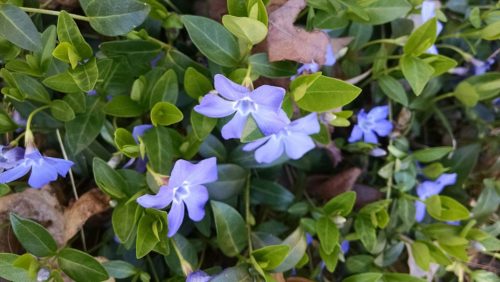Periwinkle, an evergreen, ground-covering shrub. Popular garden plant
There are two species of periwinkle:
Lesser periwinkle (Vinca minor)
Large periwinkle (Vinca major)
You are viewing the mobile-adapted version of the page.
The one for tablets, laptop and desktop also provides general information, such as origin, toxicity and cultivation.
Periwinkle – (Vinca), evergreen, ground-covering shrub. Periwinkles do not grow taller than + 40 cm (lesser periwinkle) and + 60 cm (large periwinkle), but easily cover a square meter. The flexible branches can grow one to two meters long.
The large periwinkle blooms for much of the year with single, blue flowers. The lesser periwinkle has varieties with white, purple-red and violet flowers.
Periwinkle is a strong plant, likes a humus-rich soil both in full sun and (semi-)shade. The small periwinkle is hardy, the large one a little less so it is more suitable for a sheltered spot in the garden.
Periwinkle tolerates drought poorly, especially when in full sun.
Lesser periwinkle is native to Europe and western Asia.
The name periwinkle is shared with the related evergreen perennial Catharanthus roseus or ‘rose periwinkle’.
Bugs
Periwinkle is not plagued by insects, snails and slugs.
Fungi & diseases
Brown spots with gray fungus: gray mold.

Small brown spots on the leaf, growing into large spots, after which the leaf yellows, curls and dies: Alternaria.
The fine roots wear down and rot away: root rot (Pythium).
Other
Leaf curls and dries out: water shortage.

